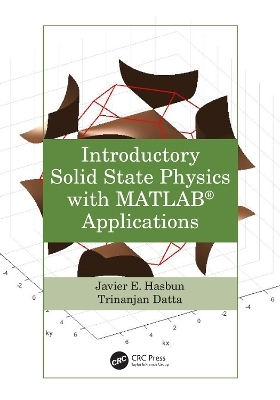
Introductory Solid State Physics with MATLAB Applications
Crc Press Inc (Verlag)
978-1-4665-1230-6 (ISBN)
Solid state physics, the study and prediction of the fundamental physical properties of materials, forms the backbone of modern materials science and has many technological applications. The unique feature of this text is the MATLAB®-based computational approach with several numerical techniques and simulation methods included. This is highly effective in addressing the need for visualization and a direct hands-on approach in learning the theoretical concepts of solid state physics. The code is freely available to all textbook users.
Additional Features:
Uses the pedagogical tools of computational physics that have become important in enhancing physics teaching of advanced subjects such as solid state physics
Adds visualization and simulation to the subject in a way that enables students to participate actively in a hand-on approach
Covers the basic concepts of solid state physics and provides students with a deeper understanding of the subject matter
Provides unique example exercises throughout the text
Obtains mathematical analytical solutions
Carries out illustrations of important formulae results using programming scripts that students can run on their own and reproduce graphs and/or simulations
Helps students visualize solid state processes and apply certain numerical techniques using MATLAB®, making the process of learning solid state physics much more effective
Reinforces the examples discussed within the chapters through the use of end-of-chapter exercises
Includes simple analytical and numerical examples to more challenging ones, as well as computational problems with the opportunity to run codes, create new ones, or modify existing ones to solve problems or reproduce certain results
Javier E. Hasbun is a Professor of Physics in the Department of Physics at the University of WestGeorgia, Carrollton, GA. He obtained his B.S in Physics from the Massachusetts College of Liberal Arts, North Adams, MA. He obtained his M.S. and Ph.D. from the University of New York atAlbany, Albany, NY in theoretical solid state physics. His post-doctoral experience was obtained from the Naval Air Warfare Center - Weapons Division, China Lake, CA. He has been at the University of West Georgia since 1990 and has taught courses in lower and upper level physics. He is a lifetime member of the American Physical Society, the American Association of Physics Teacher, the Sigma Xi Scientific Research Society, and the Georgia Academy of Science. His specialty is theoretical Solid State Physics, and conducts research in the electronic properties of solids. He is also interested in developing methods that use computers to enhance physics learning and teaching. He has published research in professional journals and presentations dealing with teaching and/or research in physics. To learn more, visit http://www.westga.edu/ jhasbun/. Trinanjan Datta is a Professor of Physics in the Department of Chemistry and Physics at Augusta University, Augusta, GA. He obtained his B.S in Physics from the University of Calcutta (St.Xavier’s College, Kolkata, India), M.S. from the Indian Institute of Technology (Kanpur, India), and his doctoral degree in theoretical condensed matter physics from Purdue University (West Lafayette, IN, USA). His research interests include theoretical and computational studies of magnetic systems and the scholarship of teaching and learning (SoTL). He has published numerous research articles on magnetism and delivered several invited national and international research presentations. Dr.Datta actively mentors undergraduate research students at Augusta University and masters and doctoral students at Sun Yat-Sen University. He is the recipient of the Augusta State University Louis K. Bell Alumni Research Award, the Kavli Institute for Theoretical Physics (KITP) scholar award, the University System of Georgia SoTL fellowship, and Augusta University Individual Teaching Excellence Award. He is a member of the Anacapa Society and the American Physical Society. To learn more, visit http://spots.gru.edu/tdatta/index.html.
1 Introduction
2 The Reciprocal Lattice
3 Crystal Binding
4 Lattice Vibrations
5 Free Electron Gas
6 Introduction to Electronic Energy Bands
7 Semiconductor Crystal Properties
8 Simple Band Structure Calculations
9 Impurities and Disordered Systems
10 Magnetism I
11 Magnetism II
12 Superconductivity
13 Optical Properties of Solids
14 Transport Properties of Solids
Appendix A: MATLAB TUTORIAL
Appendix B: Distribution Functions
Bibliography
Index
| Erscheinungsdatum | 07.10.2019 |
|---|---|
| Zusatzinfo | 40 Tables, black and white; 247 Illustrations, black and white |
| Verlagsort | Bosa Roca |
| Sprache | englisch |
| Maße | 178 x 254 mm |
| Gewicht | 1147 g |
| Themenwelt | Naturwissenschaften ► Biologie |
| Naturwissenschaften ► Chemie | |
| Naturwissenschaften ► Physik / Astronomie ► Festkörperphysik | |
| Technik ► Maschinenbau | |
| ISBN-10 | 1-4665-1230-X / 146651230X |
| ISBN-13 | 978-1-4665-1230-6 / 9781466512306 |
| Zustand | Neuware |
| Haben Sie eine Frage zum Produkt? |
aus dem Bereich


